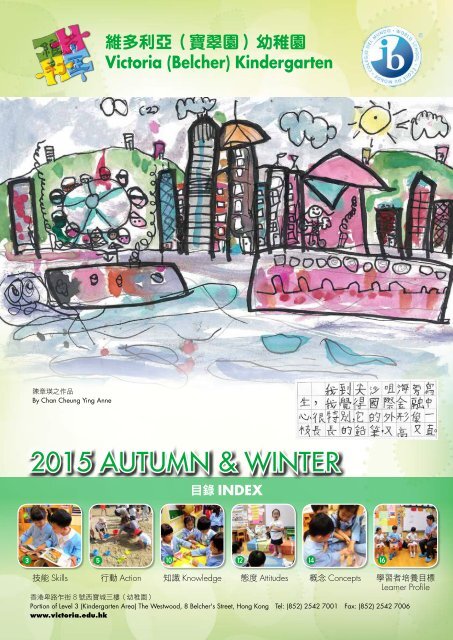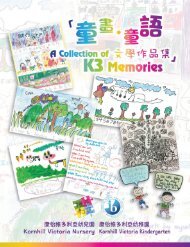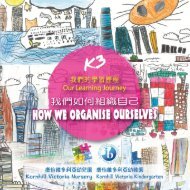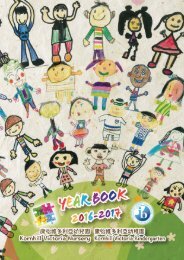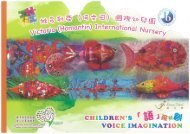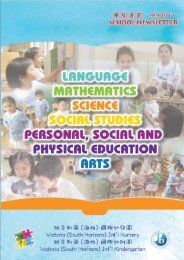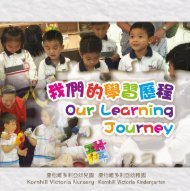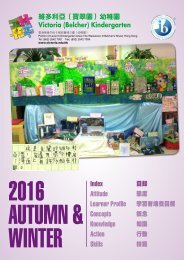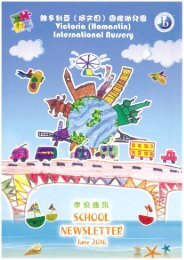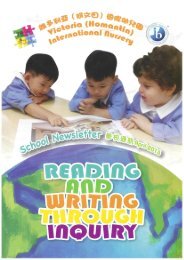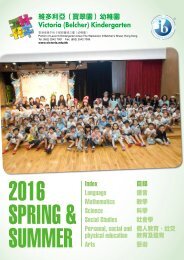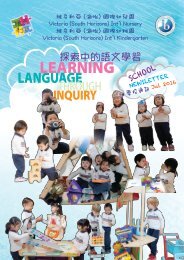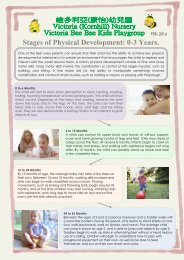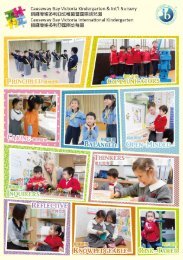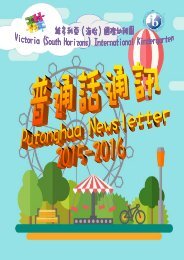BV newsletter-2015(AutumnAndWinter)
You also want an ePaper? Increase the reach of your titles
YUMPU automatically turns print PDFs into web optimized ePapers that Google loves.
維 多 利 亞 ( 寶 翠 園 ) 幼 稚 園<br />
Victoria (Belcher) Kindergarten<br />
陳 章 瑛 之 作 品<br />
By Chan Cheung Ying Anne<br />
<strong>2015</strong> AUTUMN & WINTER<br />
目 錄 INDEX<br />
3 <br />
技 能 Skills<br />
行 動 Action<br />
知 識 Knowledge<br />
態 度 Attitudes<br />
概 念 Concepts<br />
學 習 者 培 養 目 標<br />
Learner Profile<br />
香 港 卑 路 乍 街 8 號 西 寶 城 三 樓 ( 幼 稚 園 )<br />
Portion of Level 3 (Kindergarten Area) The Westwood, 8 Belcher's Street, Hong Kong Tel: (852) 2542 7001 Fax: (852) 2542 7006<br />
www.victoria.edu.hk
Chief Principal’s Message – Dr Maggie Koong<br />
I wish to begin this <strong>newsletter</strong> with a big congratulations to all students and teachers at Belcher campus for their<br />
recent IB Learning Exhibition. I was truly impressed by the meticulous preparation and presentations exhibited<br />
by the students and teachers. The event was a great opportunity to welcome parents and guests into the school<br />
community to experience the learning that happens in our classrooms.<br />
As one of our first authorized<br />
IB World Schools, Belcher truly<br />
demonstrates the art of inquirybased<br />
learning and I was able<br />
to witness the in depth inquiry<br />
undertaken by our students. The<br />
students engaged in explorative,<br />
challenging, and meaningful<br />
activities, which allowed them<br />
to gain a greater knowledge<br />
and interest in the world around<br />
them. I was surprised to see the<br />
wealth of knowledge presented,<br />
such as the detailed accounts<br />
of the different countries. It was<br />
very interesting to read about the<br />
customs, food, languages, and<br />
famous people of Iceland and Japan! It was also wonderful to see the children using a variety of media and art<br />
forms to present their inquiry learning. The K3’s studied about artists from around the world, such as Vincent van<br />
Gogh and Claude Monet, and they were able to recreate their own art pieces using a variety of styles. I am so<br />
proud of the students for their ability to showcase their learning in so many ways!<br />
Over the past few years, our organisation has implemented the inquiry based learning curriculum along with<br />
an emphasis on literacy development. By interweaving the Teacher’s College Reading and Writing literacy<br />
programme with our IB curriculum, we are building on student’s knowledge in language use and encouraging<br />
them to become more capable and confident language users. During the exhibition, the children were able<br />
to document their knowledge in writing, and the full day K2 class demonstrated different reading strategies.<br />
With this literacy growth, the students are now able to conduct their own research and inquiry to facilitate their<br />
learning.<br />
As Prof. Stephen Krashen, a well-respected Linguistics and Educator who recently visited Hong Kong, suggested,<br />
bilingual learning requires adequate input and exposure. Our teachers and schools will be cooperating by<br />
implementing more language based teaching methods into the classroom and provide the children with a rich<br />
language environment and condition for literacy acquisition.<br />
We hope that with high language proficiency and a global perspective, our students will grow into international<br />
citizens who are able to explore the world and global community.<br />
2<br />
Victoria (Belcher) Kindergarten
技 能 SKILLS<br />
Skills are the fundamental element in life, they underpin all other areas. That is why I am constantly<br />
encouraging children to do things for themselves, changing shoes, doing up buttons, dressing themselves are all<br />
independence skills and support motor control and build confidence.<br />
How do you feel when you finally manage to do something you have been trying to master? Just the same as<br />
your child - a huge sense of pride in your achievement and a notch up in self confidence.<br />
Social skills are another key in early years education, learning how to listen, engage with others, respond when<br />
spoken to, to share, take responsibility for our actions and resources. Without these basic skills, how would you<br />
function at work?<br />
These skills are all part of the IB curriculum, and as the children progress through the kindergarten, they build<br />
on these basic skills; going from gaining understanding – comprehension, to analysing one’s own and others’<br />
thinking – metacognition; from formulating questions – inquiry, to analyzing and drawing conclusions from data<br />
– interpreting data.<br />
Please support your child by supporting them in gaining skills to become an independent life-long learner.<br />
Maggie Bacon<br />
English Head Teacher<br />
Literacy Coach<br />
These girls are using their selfmanagement<br />
skills to put on their socks<br />
and shoes after a foot-drawing activity.<br />
Andrea and Momo<br />
are using their thinking<br />
skills to comprehend<br />
new information they<br />
gain from doing<br />
partner reading. They<br />
discuss and share<br />
opinions with each<br />
other to broaden their<br />
understanding and perspective of different topics.<br />
Ivanna, Lucas, and Jayden are using their<br />
communication skills during literacy hour.<br />
Ivanna is expressing her ideas clearly by<br />
speaking while Lucas and Jayden actively<br />
listen to her summer holiday story.<br />
Aiden is demonstrating his pencil-handling<br />
skills during Writer’s Workshop.<br />
維 多 利 亞 ( 寶 翠 園 ) 幼 稚 園 3
The K3 students are using their social<br />
skills when trying to untangle themselves<br />
in the game Human Knot.<br />
Wyatt (K3) and Lincoln<br />
(K2) are sharing<br />
and respecting each<br />
other’s writing. They<br />
are celebrating and<br />
appreciating each<br />
other’s love and<br />
achievement in writing.<br />
技 能<br />
為 了 開 展 有 目 的 的 探 究 , 同 時 為 學 生 成 為 終 身 的 學 習 者 做 好 準<br />
備 , 探 究 式 學 習 強 調 學 生 需 要 掌 握 一 整 套 的 各 種 技 能 。 這 些 技 能<br />
包 括 與 所 有 學 科 相 關 的 技 能 , 還 包 括 了 超 越 所 有 學 科 的 技 能 , 學<br />
生 需 要 這 些 技 能 充 分 支 持 他 們 應 對 複 雜 的 生 活 。<br />
在 探 究 式 學 習 的 自 始 至 終 , 學 生 將 學 習 得 並 應 用 一 整 套 的 超 學 科<br />
技 能 , 包 括 : 社 交 技 能 、 溝 通 技 能 、 思 考 技 能 、 研 究 技 能 以 及 自<br />
我 管 理 技 能 。 這 些 技 能 不 僅 對 探 究 單 元 有 價 值 , 對 課 堂 外 的 各 種<br />
教 學 與 學 習 的 活 動 以 及 校 外 的 生 活 也 都 非 常 有 價 值 。<br />
王 楚 寧 老 師<br />
幼 兒 班 幼 兒 在 學 習 「 我 們 是 誰 」 的 超 學 科<br />
主 題 時 , 通 過 角 色 扮 演 的 遊 戲 來 認 識 我 們<br />
的 身 體 。 幼 兒 在 活 動 中 扮 演 醫 生 及 護 士 ,<br />
共 同 合 作 來 進 行 遊 戲 , 他 們 從 中 習 得 了 基<br />
本 的 社 交 技 能 , 例 如 尊 重 他 人 及 互 相 合 作 。<br />
茶 點 時 段 , 幼 兒 懂 得 排 隊 洗 手 以 及 輪 候 拿 取<br />
食 物 , 這 反 映 了 他 們 都 能 遵 守 課 室 的 規 則 。<br />
在 自 選 活 動 時<br />
段 , 幼 兒 一 起<br />
閱 讀 書 籍 以 獲<br />
取 信 息 , 她 們<br />
更 會 討 論 故 事<br />
中 的 人 物 和 情<br />
節 , 這 展 現 了<br />
基 本 的 溝 通 技<br />
能 。<br />
4<br />
Victoria (Belcher) Kindergarten
行 動 ACTION<br />
「 展 示 及 探 究 日 」<br />
「 展 示 及 探 究 日 」 於 1 月 下 旬 順<br />
利 完 成 , 我 們 一 起 慶 祝 高 班 的 學<br />
習 旅 程 , 幼 兒 將 跨 學 科 主 題 -「 我<br />
們 身 處 甚 麼 時 空 」 舉 行 一 個 展 覽 ,<br />
展 示 及 匯 報 他 們 當 中 的 過 程 及 成<br />
果 , 幼 兒 以 不 同 的 表 達 形 式 來 展<br />
示 他 們 對 香 港 與 世 界 各 地 的 相 同<br />
及 相 異 之 處 , 向 嘉 賓 、 家 長 等 介<br />
紹 展 覽 的 內 容 , 以 行 動 將 他 們 所<br />
知 所 學 的 與 別 人 分 享 。<br />
Exhibition Day<br />
Exhibition Day was held at the<br />
end of January, we celebrated<br />
the K3’s learning journey. Upper<br />
class children invited parents<br />
to join their Exhibition “Where<br />
we are in time and place”.<br />
They chose a different format to<br />
display and present what they<br />
had learnt, they presented their<br />
knowledge and understanding<br />
of how Hong Kong is similar<br />
and different to other countries<br />
around the world to guests and<br />
parents, they were eager to<br />
share with others.<br />
高 班 學 生 代 表 到 香 港 濕 地 公 園 參 加 第 九 屆 「 濕 地 劇 場 說 故 事 比 賽 」, 幼<br />
兒 以 故 事 「 玩 轉 濕 地 好 朋 友 」 帶 出 人 類 已 逐 漸 破 壞 濕 地 的 環 境 , 珍 貴 的<br />
資 源 越 見 稀 有 , 希 望 彼 此 反 思 人 類 與 環 境 的 關 係 。 比 賽 中 , 他 們 除 了 帶<br />
出 重 要 的 訊 息 外 , 更 顯 見 他 們 的 自 信 、 勇 氣 、 投 入 及 互 相 欣 賞 的 態 度 ,<br />
最 後 他 們 更 榮 獲<br />
亞 軍 殊 榮 。<br />
維 多 利 亞 ( 寶 翠 園 ) 幼 稚 園 5
專 業 分 享 與 交 流<br />
每 年 度 機 構 也 鼓 勵 老 師 到 海 外 作 專 業 培 訓 , 讓 她 們 能 持 續 地 進 修 、 培 養 老 師 的 國 際 情 懷 以 及 促 進 她 們 不 斷 反 思 和 提<br />
昇 專 業 技 能 。 本 園 在 <strong>2015</strong>-2016 年 度 上 學 期 , 老 師 曾 到 美 國 、 星 加 坡 、 中 國 等 地 參 加 工 作 坊 、 教 育 研 討 會 等 , 與 當<br />
地 進 行 專 業 交 流 , 從 中 獲 得 豐 富 的 專 業 知 識 。<br />
Professional Sharing<br />
VEO Organisation encourages teachers to participate in overseas professional training, nurturing teachers’<br />
global insight and enhancing teachers’ ability and reflectiveness. In the academic year <strong>2015</strong>-2016, our<br />
teachers went to USA, Singapore and China, to attended workshops, teaching seminars and conferences, to<br />
gain some new ideas and perspectives from different countries, and other IB teachers from around the world.<br />
Columbia University Reading and Writing Project<br />
Along with four other English Head teachers, I was very lucky to have the<br />
opportunity, in August, to attend Columbia University in New York to learn how<br />
the Writers Workshop runs in the Teacher College Reading and Writing Project<br />
method of teaching. I love how it is so thorough, giving all areas of the writing<br />
process equal importance; structure, development and Language conventions.<br />
It has been a pleasure working with the English and Chinese team to implement<br />
some elements of the project in school this year and see the pleasure, growth and<br />
confidence of the children as well as the growth in the teachers. A win, win project<br />
I would say. I look forward to its further development over the coming years.<br />
Maggie Bacon<br />
English Head Teacher<br />
幼 兒 戲 劇 魔 法 師 訓 工 作 坊 體 會<br />
12 月 中 旬 , 我 們 參 加 了 由 台 灣 資 深 的 兒 童 創 意 戲 劇 大 師<br />
王 立 安 領 銜 主 持 為 期 三 天 的 戲 劇 魔 法 師 訓 工 作 坊 。 此 工<br />
作 坊 旨 在 培 養 創 意 戲 劇 種 子 教 師 , 指 導 老 師 們 如 何 用 開<br />
放 的 教 學 方 式 , 啟 發 孩 子 們 充 分 感 受 與 思 考 , 借 助 肢 體 、<br />
材 料 , 在 多 元 的 環 境 中 , 與 藝 術 、 音 樂 、 文 學 的 美 麗 邂<br />
逅 , 自 由 表 達 對 世 界 的 認 識 與 理 解 。 在 三 天 的 培 訓 學 習<br />
當 中 , 我 們 透 過 肢 體 大 開 放 的 創 意 戲 劇 遊 戲 , 快 速 進 入<br />
了 戲 劇 的 世 界 。 老 師 們 從 日 常 生 活 及 繪 本 中 取 材 , 加 入<br />
想 象 與<br />
狂 想 元<br />
素 , 結<br />
合 創 造 力 戲 劇 肢 體 的 表 演 形 式 , 創 造 了 充 滿 驚 喜 改 編 自 童 話 故 事 和 兒<br />
童 繪 本 故 事 的 短 劇 《 白 雪 公 主 與 七 個 小 矮 人 》 以 及 《 遲 到 大 王 》。 通<br />
過 這 次 難 忘 的 學 習 體 驗 , 學 習 並 且 了 解 透 過 兒 童 創 意 戲 劇 , 如 何 提 昇<br />
兒 童 發 展 想 象 力 、 創 造 力 、 自 信 心 、 表 演 力 、 與 他 人 的 協 作 能 力 以 及<br />
分 析 問 題 解 決 問 題 的 能 力 等 , 讓 孩 子 創 作 與 完 成 充 滿 情 境 與 戲 劇 張 力<br />
的 創 意 戲 劇 表 演 。<br />
陳 淑 娉 老 師 傅 立 老 師<br />
6<br />
Victoria (Belcher) Kindergarten
親 子 同 樂<br />
「 愛 心 親 子 運 動 會 」 及 「 親 子 旅 行 」 讓 幼 兒 與 家 長 能 夠 共 同 體 驗 做 運 動 的 樂 趣 、 積 極 投 入 認 識 周 邊 大 自 然 的 事 物 ,<br />
更 能 夠 增 進 了 親 子 關 係 , 好 好 一 起 遊 覽 大 自 然 的 景 色 。<br />
Parent-Child Enjoyment<br />
Children enjoyed the fun of exercise, and exploring nature with their parents at the 50th Golden Jubilee<br />
Anniversary Love and Fun Sports Day and Picnic. It was lovely to see the relationships between children and<br />
parents, appreciating being outside in the natural environment.<br />
「 愛 心 親 子 運 動 會 」<br />
「 愛 心 親 子 運 動 會 」 於 11 月 22 日 在<br />
小 西 灣 運 動 場 舉 辦 , 當 天 高 班 幼 兒 參 與<br />
了 當 中 的 升 旗 禮 、 儀 仗 隊 及 啦 啦 隊 , 而<br />
各 級 亦 有 不 同 的 表 演 。 運 動 會 當 天 幼 兒<br />
與 家 長 興 高 采 烈 地 參 加 各 類 親 子 運 動 遊<br />
戲 , 共 同 體 驗 做 運 動 的 樂 趣 。<br />
Love and Fun Sports Day<br />
Love and Fun Sports Day was held<br />
on 22nd November at Siu Sai<br />
Wan Sports Ground. On that day,<br />
K3 children were involved in flag<br />
raising, the honour guard and cheer<br />
leading and K1-K3<br />
performances. Child<br />
and parents were<br />
excited to participate<br />
in different games,<br />
enjoying the experience<br />
of sports day.<br />
親 子 旅 行<br />
小 組 及 幼 兒 班 的 親 子 旅 行 於 錦 田 鄉 村 俱 樂 部 舉<br />
行 。 他 們 與 班 中 幼 兒 玩 集 體 遊 戲 , 一 起 遊 覽 大 自<br />
然 的 景 色 , 認 識 周 邊 的 事 物 , 更 能 夠 增 進 了 親 子<br />
關 係 。<br />
Parent-Child Picnics<br />
Pre-nursery and Nursery Class went to Kam<br />
Tin Country Club, they enjoyed the picnic and<br />
exploring the natural environment, playing with<br />
their friends and family.<br />
維 多 利 亞 ( 寶 翠 園 ) 幼 稚 園 7
而 低 班 和 高 班 的 幼 兒 則 分 別 前 往 深 水 灣 沙 灘 作 海 灘 歷 奇 及 香 港 仔 郊 野 公 園 健 身 徑 ( 上 水 塘 段 ) 作 野 外 定 向 , 他 們 憑 著<br />
觀 察 、 閱 讀 及 思 考 能 力 解 決 問 題 , 同 樣 以 積 極 和 好 學 的 態 度 來 認 識 周 邊 的 事 物 。<br />
Lower class went to Deep Water Bay Beach and Upper class went to Aberdeen Country Park Fitness Trail<br />
(Upper Reservoir) for orienteering.<br />
The purpose was to encourage<br />
parents and children to participate<br />
together engaging with the<br />
environment; making observations,<br />
reading information plaques, testing<br />
their fitness, learning and having<br />
fun, whilst answering the activity<br />
booklet.<br />
社 區 學 習<br />
社 區 學 習 是 一 種 以 行 動 實 踐 學 習 的 方 式 , 更 能 擴 闊 幼 兒 的 學 習 視 野 , 過 程 中 使 幼 兒 能 觀 察 及 探 索 一 些 熟 悉 及 新 鮮 的<br />
事 物 從 而 建 構 其 新 的 知 識 , 因 此 我 們 致 力 替 幼 兒 營 造 不 同 的 社 區 學 習 機 會 。<br />
Learning Community<br />
A learning community is action learning together. Children learn from each other, broadening their horizons,<br />
observing and exploring new and familiar things, processing these shared experiences and constructing new<br />
knowledge. We are committed to constructing a diverse community of learning opportunities.<br />
呂 淑 君 主 任 / 國 際 文 憑 ( 小 學 項 目 ) 協 調 員<br />
Sharon Lui, Chinese Head Teacher/PYP Coordinator<br />
幼 兒 班 Nursery Class<br />
動 植 物 公 園<br />
藉 此 提 高 幼 兒 對 動 植 物 的 認 識 , 並 學 習 欣 賞 及 重 視 不 同 的 動 植 物 。<br />
Hong Kong Zoological and Botanical Garden<br />
This field trip provided opportunities for the children to find out more about animals and plants.; enabling them<br />
to foster an understanding and appreciation of all living things.<br />
8<br />
Victoria (Belcher) Kindergarten
低 班 Lower Class<br />
陽 光 笑 容 小 樂 園<br />
低 班 學 生 參 觀 衛 生 署 口 腔 健 康 教 育 組 之 「 陽 光 笑 容 小 樂 園 」, 透 過 一 些 扮 演 遊 戲 活 動<br />
加 強 幼 兒 對 護 齒 的 認 識 及 從 小 養 成 保 護 牙 齒 健 康 的 習 慣 。<br />
Brighter Smiles Playland<br />
K2 children visited Brighter Smiles<br />
Playland. A variety of interactive games<br />
helped children to become aware of the<br />
importance of brushing their teeth and<br />
general oral hygiene.<br />
高 班 Upper Class<br />
九 龍 寨 城 公 園<br />
高 班 幼 兒 親 身 接 觸 香 港 近 代 歷 史 其 中 一 個 最 重 要 的 遺 蹟 - 九 龍 寨 城 公 園 , 初 步 認 識 到 香 港 的 文 化 及 歷 史 , 更 可 欣<br />
賞 到 公 園 中 古 色 古 香 的 建 築 物 、 歷 史 遺 跡 等 , 令 幼 兒 對 自 己 的 社 會 文 化 、 當 中 的 轉 變 有 更 深 的 認 識 。<br />
Kowloon Walled City Park<br />
K3 children had the opportunity to go back in time at Kowloon Walled City Park and experience a little of<br />
what life in this haven of crime and debauchery was like. They were fascinated by the old buildings and<br />
how life was for those that lived and worked in them. They now have a real appreciation of how life in Hong<br />
Kong has changed.<br />
行 動 是 推 行 國 際 文 憑 課 程 的 重 要 元 素 , 行 動 的 作 用 是 希 望 幼 兒 進 行 反<br />
思 、 選 擇 和 行 動 。 而 行 動 可 以 是 幼 兒 自 發 的 或 是 由 老 師 提 供 機 會 。<br />
行 動 建 基 於 一 連 串 充 實 的 學 習 歷 程 , 並 在 已 有 知 識 上 建 構 新 知 識 , 從<br />
而 引 導 幼 兒 進 行 明 確 和 有 意 義 的 學 習 體 驗 , 最 後 透 過 行 動 展 現 出 來 。<br />
陳 慧 姿 老 師<br />
小 組 班 幼 兒 於 「 從 頭 動 到 腳 」 的 單 元 中 ,<br />
幼 兒 能 運 用 身 體 各 部 位 做 出 不 同 的 動 作 ,<br />
幼 兒 觀 察 同 伴 的 動 作 後 , 嘗 試 把 同 伴 的 動<br />
作 利 用 繪 畫 的 形 式 記 錄 下 來 。<br />
小 組 班 幼 兒 於 「 從 頭 動 到<br />
腳 」 的 單 元 中 , 認 識 臉 部<br />
器 官 的 名 稱 及 位 置 後 , 把<br />
臉 部 器 官 的 圖 片 拼 貼 在 紙<br />
碟 上 製 作 臉 譜 。<br />
維 多 利 亞 ( 寶 翠 園 ) 幼 稚 園 9
知 識 KNOWLEDGE<br />
Knowledge is one of the essential elements of the PYP curriculum. Knowledge transcends subject areas and<br />
boundaries and helps to keep the curriculum engaging, challenging and significant.<br />
Children gain knowledge by spending time exploring and engaging in the world around them. It is not just<br />
simply by memorising information but through hands on inquiry experiences, and reflecting on their findings.<br />
We aim to guide our children as they explore and help them gain new knowledge in all areas.<br />
Sebastian is constructing his knowledge of the role of bones in our<br />
body. He understands that bones are hidden in our body, and they play<br />
a fundamental role in keeping us up and<br />
giving us the body structure and shape<br />
that we have. Moreover, this knowledge<br />
can be extended to promote further<br />
thinking such as: what other living things<br />
also have bone? Do all humans have the<br />
same number of bones?<br />
The children in K1 are using their senses to build their knowledge of<br />
how flour feels. This is linked to building a deeper understanding of<br />
the mid-autumn festival of lights and<br />
how mooncakes are a part of how we<br />
celebrate this festival in Hong Kong.<br />
They might also have made links to<br />
their knowledge of how lights are also<br />
used and latkas are eaten with family<br />
members celebrating Hanukah.<br />
Ms Penelope<br />
These K2 students demonstrated<br />
their knowledge about how to<br />
care for teeth during a visit to<br />
Brighter Smiles.<br />
In the unit “Where We Are in Place and Time”, the students observed<br />
and sketched an observational<br />
drawing of the Hong Kong skyline<br />
to build onto their prior knowledge<br />
of their hometown, Hong Kong.<br />
Through this hands-on experience,<br />
they constructed new knowledge<br />
about how Hong Kong is unique<br />
and different from other places.<br />
Knowledge is constructed through<br />
exploration and experiences.<br />
These K3 students are gaining<br />
knowledge about sea creatures<br />
and numbers through a handson<br />
centre with slime. Look how<br />
much fun they are having!<br />
The K1 children are<br />
applying and sharing<br />
their knowledge of<br />
numbers in the number<br />
centre.<br />
These K2 students are<br />
gaining knowledge<br />
in a new sport –<br />
fencing! They learn<br />
the objectives, rules,<br />
and sportsmanship of<br />
this traditional sport.<br />
10<br />
Victoria (Belcher) Kindergarten
如 何 學 習 新 知 識<br />
在 課 堂 學 習 的 過 程 中 , 幼 兒 是 一 個 積 極 的 探 究 者 ,<br />
教 師 的 作 用 是 要 提 供 幼 兒 一 個 能 夠 獨 立 探 究 的 情<br />
境 , 而 不 是 提 供 現 成 的 知 識 。 幼 兒 學 習 不 同 學 科<br />
知 識 的 時 候 , 我 們 不 必 在 他 們 的 腦 袋 中 建 造 一 座<br />
小 型 圖 書 館 , 而 是 要 讓 幼 兒 學 習 自 己 去 思 考 , 參<br />
與 知 識 獲 得 的 過 程 。<br />
事 實 上 ,「 認 識 」 是 一 個 過 程 , 而 不 是 一 種 「 產<br />
品 」, 學 習 的 主 要 目 的 不 是 要 記 住 教 師 和 書 本 上<br />
所 講 的 內 容 , 而 是 要 讓 幼 兒 參 與 建 立 該 學 科 知 識<br />
的 過 程 。 教 育 學 家 布 魯 納 亦 強 調 「 學 生 不 是 被 動<br />
的 、 消 極 的 知 識 接 受 者 , 而 是 主 動 的 、 積 極 的 知<br />
識 探 究 者 。」<br />
透 過 本 校 的 「 國 際 文 憑 課 程 」(「 幼 小 課 程 」),<br />
教 師 從 不 同 的 探 索 活 動 中 提 供 幼 兒 真 實 的 體 驗 機<br />
會 , 特 別 是 鼓 勵 幼 兒 自 行 從 書 中 找 出 答 案 , 並 從<br />
中 支 持 及 培 養 幼 兒 發 展 探 索 、 社 交 、 思 考 、 溝 通<br />
和 自 我 管 理 等 不 同 的 技 能 , 讓 幼 兒 在 活 動 的 過 程<br />
中 , 主 動 學 習 更 多 不 同 的 新 知 識 。<br />
紀 建 茵<br />
圖 書 館 老 師<br />
Children are active enquirers. Teachers are not providers<br />
of “ready-made” knowledge. On the contrary, they need<br />
to help children to acquire knowledge independently in<br />
different learning processes. There is no need to construct<br />
a mini library in a child’s brain. Instead, the teacher helps<br />
to facilitate children’s learning by providing an environment<br />
for them to think independently.<br />
In fact, “getting to know” is a process, not a product. The<br />
main purpose of learning is not to let children remember<br />
what the teachers say in the lessons or the subject<br />
knowledge mentioned in the textbook. Therefore, learning is<br />
a process for children to acquire knowledge in the learning<br />
process. Educator Bruner says “Students are not passive<br />
recipients of knowledge, but active, positive knowledge<br />
inquirers”.<br />
Through the IB curriculum, teachers provide opportunities for<br />
children to experience in the inquiry learning centres, library<br />
encouraging children to find answers from their inquiry and<br />
books. Thus teachers give support to children to help them<br />
to develop inquiry, social, thinking, communication and<br />
self-management skills so that they can participate actively<br />
in their learning process.<br />
Caroline KEE, Teacher Librarian<br />
維 多 利 亞 ( 寶 翠 園 ) 幼 稚 園 11
態 度 ATTITUDES<br />
In the PYP curriculum, attitudes ask the question: what do we want students to feel, value, and demonstrate? To<br />
create global citizens, the PYP focuses on developing attitudes towards people, the environment, and learning.<br />
There are twelve main attitudes chosen to encourage our students to display: appreciation, commitment,<br />
confidence, cooperation, creativity, curiosity, empathy, enthusiasm, independence, integrity, respect, and<br />
tolerance. These attitudes contribute to the well-being of both the individual and the group; therefore, PYP is a<br />
values-based curriculum. Teachers at Belcher’s Victoria Kindergarten believe in these attitudes and strive to model<br />
them every day for their students.<br />
Ms Erin<br />
The K2A1pm<br />
class learned a<br />
new maths game<br />
called “Diamonds<br />
and Rubies.” In the<br />
game, they had to<br />
cooperate to take<br />
turns and play fairly.<br />
The K3 students are cooperating to<br />
build a tower using marshmallows and<br />
spaghetti.<br />
Lisa and Sophie<br />
d e m o n s t r a t e<br />
independence when<br />
reading books during<br />
reading workshop. They<br />
apply reading strategies<br />
acquired previously to<br />
help themselves read<br />
independently without<br />
the teacher.<br />
Liam and Gabby show commitment in<br />
learning to play a new instrument. They<br />
practise playing the ukulele together<br />
once a week and they are committed to<br />
never give up learning!<br />
Cheryl and Eliana<br />
in K1A2 are<br />
demonstrating<br />
cooperation by<br />
working together<br />
on the class’ human<br />
body diagram.<br />
Zevida demonstrates confidence when<br />
presenting in front of her classmates.<br />
12<br />
Victoria (Belcher) Kindergarten
多 元 化 的 活 動 能 夠 培 養 學 習 者 的 良 好 「 態 度 」<br />
幼 小 項 目 中 培 養 幼 兒 的 十 二 種 態 度 , 越 早 的 態 度 培 養 越 為 重 要 , 且 收 效 亦 大 。 學 校 不 同 角 落 的 設 置 及 透 過 不 同 種 類<br />
的 活 動 , 培 養 幼 兒 不 同 「 態 度 」, 環 境 刺 激 幼 兒 的 思 維 , 讓 幼 兒 和 環 境 起 交 互 作 用 , 能 夠 在 適 切 的 環 境 及 活 動 中 學 習 ,<br />
以 達 致 學 習 的 效 果 。<br />
在 設 計 活 動 時 , 教 師 會 留 意 活 動 的 學 習 目 標 及 關 顧 幼 兒 發 展 , 讓 幼 兒 在 豐 富 及 具 學 習 意 義 的 環 境 下 , 能 夠 有 自 信 地<br />
參 與 不 同 活 動 , 表 現 出 對 學 習 的 熱 誠 與 投 入 。<br />
在 不 同 的 社 區 學 習 活 動 , 讓 幼 兒 學 習 對 人 與 社 區 的 尊 重 , 加 深 他 們 對 課 題 的 理 解 , 以 及 明 白 個 人 與 社 區 的 關 係 , 在<br />
已 有 知 識 下 建 構 新 知 識 , 為 幼 兒 在 學 習 旅 程 上 奠 下 良 好 的 學 習 基 礎 。<br />
The twelve attitudes of the PYP are easily developed early on in the child’s life. A range of resources and<br />
engagements encourage children to display the range of attitudes. The environment is a silent teacher in<br />
this process, offering vast opportunities when interacting with it to explore, cooperate, show curiosity, be<br />
independent and build confidence.<br />
Teachers plan not only the environment in the school but also plan for outings, constantly keeping in mind the<br />
learning intentions and ensuring that the environment or outing venue support this along with the attitudes that<br />
shape us into life-long learners and world citizens.<br />
高 志 敏 主 任<br />
從 欣 賞 學 習 尊 重 個 別 差 異<br />
透 過 一 系 列 探 索 身 體 機 能 的 活<br />
動 , 幼 兒 班 認 識 不 同 身 體 的 部 分<br />
各 有 不 同 的 功 用 , 不 但 讓 幼 兒 學<br />
習 欣 賞 自 己 的 獨 特 性 , 同 時 也 在<br />
體 會 每 個 人 的 個 別 差 異 , 培 養 幼<br />
兒 欣 賞 和 尊 重 別 人 的 態 度 。<br />
從 欣 賞 學 習 尊 重 生 命<br />
小 組 幼 兒 在 「 我 們 要 去 捉 狗 熊 」 的 學 習 單 元 中 ,<br />
透 過 尋 找 狗 熊 的 歷 險 旅 程 探 索 大 自 然 不 同 的 事<br />
物 , 以 親 身 的 經 驗 感 受 及 欣 賞 大 自 然 的 奧 妙 , 從<br />
而 學 習 尊 重 及 珍 惜 生 命 。<br />
維 多 利 亞 ( 寶 翠 園 ) 幼 稚 園 13
概 念 CONCEPTS<br />
The PYP is committed to a concept-driven curriculum<br />
to support inquiry-based learning that cultivates<br />
the understanding of significant ideas. Instead of<br />
memorizing isolated facts, students use their prior<br />
knowledge together with their new experiences<br />
gained from exploration, to construct meaning for<br />
themselves, making the understanding of concepts<br />
much deeper. As a result, concepts are an essential<br />
element of the PYP.<br />
The eight focused concepts are: form, function,<br />
causation, change, connection, perspective,<br />
responsibility, and reflection, and others are drawn in<br />
as and when they are pertinent.<br />
Parents can ask specific questions to help children<br />
think more deeply into different concepts related to<br />
the transdisciplinary theme.<br />
Form: What is it like?<br />
Function: How does it work?<br />
Causation: Why is it like it is?<br />
Change: How is it changing?<br />
Connection: How is it connected to other things?<br />
Perspective: What are the points of view?<br />
Responsibility: What is our responsibility?<br />
Reflection: How do we know?<br />
These questions foster deep thinking and link to one<br />
another, which helps children acquire and understand<br />
vital concepts that then drive further learning.<br />
Miss Jacqueline<br />
K1A2 children observed the changes made to<br />
the potatoes when cooking latkes. They realized<br />
that the potatoes went from hard to soft, and they<br />
understood that changes made to the potatoes<br />
are irreversible.<br />
The PYP curriculum is based on teaching<br />
concepts rather than teaching facts. In Writer’s<br />
Workshop, the children learned that writers can<br />
add to their writing by stapling another page<br />
to their work. The children acquired the skill of<br />
using a stapler through exploring the concept<br />
of what it means to be an author.<br />
These K3 students are<br />
making connections<br />
between shapes and<br />
building in our city by<br />
sketching the Hong<br />
Kong skyline at the<br />
harbour.<br />
14<br />
Victoria (Belcher) Kindergarten
The children from K1A1 are exploring<br />
the perspective of someone with vision<br />
impairment, how they perceive the world<br />
without sight.<br />
Wai Chi inquired into the<br />
concept of perspective by<br />
exploring the festival of Diwali.<br />
He understood the points of<br />
view of people who celebrated<br />
different festivals. He created<br />
a diva lamp for the festival of<br />
Diwali and appreciated the<br />
similarities and differences Diwali<br />
shared with other festivals of his<br />
culture.<br />
概 念 作 為 課 程 的 核 心 概 念 , 它 支 撐 了 學 生 課 程 內 外 所 有 的 探 究 活 動 。 概 念 還 可 以 在 學 習 的 過 程 中 建 立 不 同 學 科 之 間<br />
的 聯 繫 , 以 及 學 科 與 跨 學 科 之 間 的 聯 繫 。<br />
傅 立 老 師<br />
形 式 是 其 中 的 一 個 概 念 , 幼 兒 班 的 幼 兒 在 「 我 們 是 誰 」 的 單 元 活 動 中 , 透 過 談 話 、 觀 察 、<br />
比 較 , 使 幼 兒 明 白 人 與 人 之 間 的 相 似 及 不 同 之 處 。<br />
責 任 - 高 班 單 元 『 我 們 是 誰 』 幼 兒 從 不 同 的 合 作 遊 戲 中 , 學 習 到<br />
個 體 在 團 體 中 所 要 承 擔 的 責 任 。 在 與 人 交 流 、 聆 聽 他 人 、 幫 助 他<br />
人 和 表 達 自 己 後 才 能 一 起 完 成 任 務 。<br />
而 在 單 元 的 最 後 , 為 了 讓 幼 兒 透 過 行 動 去 明 白 自 己 的 責 任 。 老 師<br />
與 幼 兒 一 起 討 論 制 定 了 課 室 協 議 。 從 而 幼 兒 為 自 己 在 課 室 中 的 行<br />
為 擔 當 責 任 , 成 為 一 名 有 責 任 心 的 孩 子 。<br />
維 多 利 亞 ( 寶 翠 園 ) 幼 稚 園 15
學 習 者 培 養 目 標 LEARNER PROFILE<br />
國 際 文 憑 ( 幼 小 課 程 ) 致 力 培 養 幼 兒 成 為 具 有 國 際 情 懷 的 學 習 者 , 並 為 學 習 者 定 下 十 個 培 養 目 標 :『 探 究 者 』、『 知<br />
識 淵 博 的 人 』、『 思 考 者 』、『 交 流 者 』、『 有 原 則 的 人 』、『 胸 襟 開 闊 的 人 』、『 富 有 同 情 的 人 』、『 敢 於 冒 風<br />
險 的 人 』、『 反 思 者 』 和 『 全 面 發 展 的 人 』。 學 校 是 學 習 者 聚 集 的 小 社 區 , 以 提 供 推 動 幼 兒 的 好 奇 心 , 主 動 探 究 的<br />
國 際 化 的 學 習 者 。<br />
方 家 敏 老 師<br />
反 思 者 : 幼 兒 正 在 比 較 海 洋<br />
生 物 的 體 型 哪 個 較 大 、 哪 個<br />
較 細 少 。 他 們 在 課 室 選 出 不<br />
同 的 非 標 準 量 度 長 度 , 從 而<br />
作 出 比 較 。<br />
交 流 者 :<br />
幼 兒 正 學 習 彈 奏 夏 威 夷 小 吉 他 , 嘗 試 運<br />
用 語 言 以 外 來 與 別 人 溝 通 。<br />
思 考 者 : 幼 兒 完 成 量 度 後 , 已<br />
量 度 結 果 記 錄 下 來 ,。 他 們 需<br />
要 就 搜 集 得 來 的 資 料 作 出 分<br />
析 , 才 能 找 出 「 哪 種 海 洋 生 物<br />
的 體 型 較 大 / 較 少 」 的 答 案 。<br />
如 何 成 為 一 個 探 究 者 ?<br />
幼 兒 班<br />
超 學 科 主 題 ..「 我 們 是 誰 」<br />
中 心 思 想 .. 每 個 人 都 是 獨 特 的 及 我 們 身 體<br />
每 部 份 都 有 不 同 的 功 能<br />
重 要 概 念 .. 功 能 - 知 道 身 體 部 份 能 夠 做 到<br />
不 同 的 事<br />
馮 彧 : 我 聞 到 好 香 啊 ! 諾 謙 : 用 腳 好 難 畫 !<br />
幼 兒 透 過 不 同 的 探 究 活 動 體 驗 身 體 各 部 份 的 功 用 及 瞭 解 身 體 的 結 構 , 明 白 身 體 有 不 同 的 功 能 。 活 動 中 見 到 他 們 積 極 、<br />
主 動 、 投 入 進 行 不 同 的 探 究 活 動 , 這 探 究 精 神 能 幫 助 他 們 獲 得 更 多 的 知 識 。<br />
李 榮 君 老 師<br />
晉 健 : 要 幫 個 人 著 衫<br />
樂 熙 .. 好 酸 啊 ! 為 政 : 圓 碌 碌 , 係 圓 形 。<br />
16<br />
Victoria (Belcher) Kindergarten


